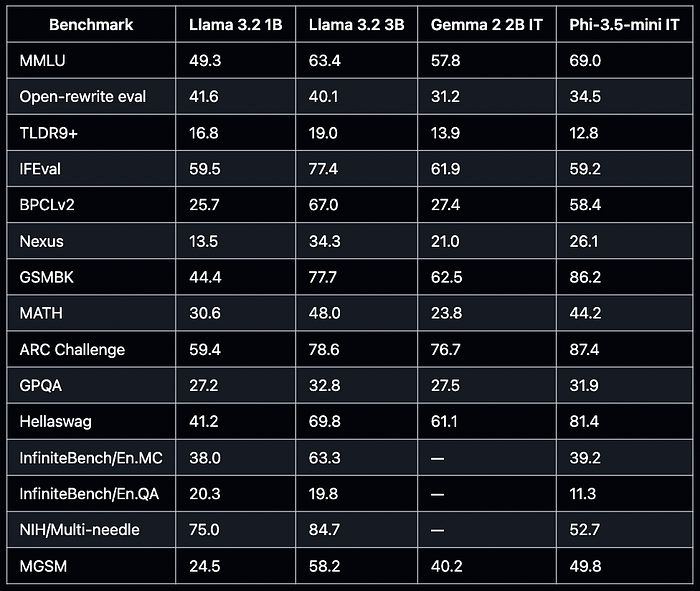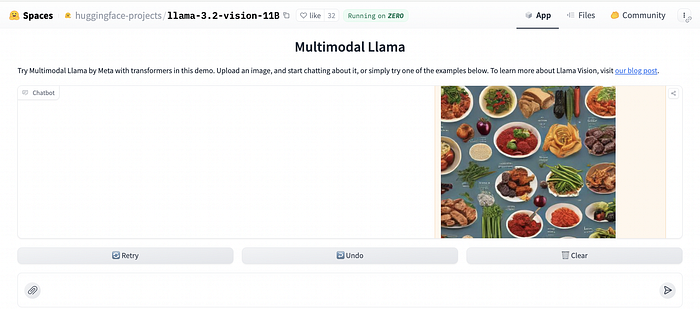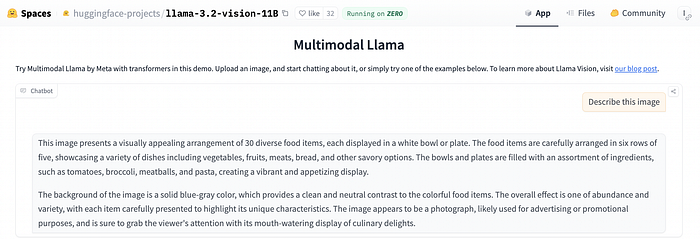Llama 3.2: Meta’s Groundbreaking Multimodal AI Model
Exploring the New Frontiers of Llama 3.2
Meta has released Llama 3.2, its latest advancement in large language models, introducing groundbreaking multimodal capabilities and improved efficiency. This guide explores the key features, improvements, and potential applications of this cutting-edge AI model, set to revolutionise the field of artificial intelligence.
Introduction to Llama 3.2
Llama 3.2 is Meta’s first open-source AI model capable of processing both text and images. This collection ranges from lightweight versions for edge devices to powerful multimodal models capable of sophisticated reasoning tasks.
Key Features and Improvements
Multimodal Capabilities
For the first time in the Llama series, the 11B and 90B models support vision tasks. These models can:
- Process high-resolution images up to 1120x1120 pixels
- Perform image captioning, visual reasoning, and document visual question-answering
- Integrate image-text retrieval capabilities
New Model Sizes
Llama 3.2 introduces four new models:
- 1B and 3B parameter models: Lightweight text-only versions for edge and mobile devices
- 11B and 90B parameter models: Larger versions with vision capabilities

Performance Enhancements
Despite their smaller size, the new models show impressive performance:
- The 3B model matches or exceeds Llama 3.1 8B on tasks like tool use and summarisation
- The 1B model rivals larger models on summarisation and re-writing tasks

Architectural Innovations
Llama 3.2 incorporates significant architectural changes for its vision models:
- A novel adapter architecture integrates image encoder representations into the language model
- Cross-attention layers feed image encoder representations into the core language model
Differences Between Llama 3.2 and Llama 3.1
Here are the key differences between Llama 3.2 and its predecessor, Llama 3.1:
1. Multimodal Capabilities
- Llama 3.2 introduces multimodal models (11B and 90B) that can process both text and images.
- Tasks include image captioning, visual reasoning, and document visual question answering.
- Llama 3.1 lacked these vision capabilities.
2. New Lightweight Models
- Llama 3.2 introduces 1B and 3B parameter text-only models for edge devices.
- Llama 3.1 did not offer such small models optimised for edge use.
3. Performance Improvements
- The 3B model in Llama 3.2 matches or exceeds Llama 3.1 8B on summarisation tasks.
- The 1B model performs well on summarisation and re-writing tasks, similar to larger models.
4. Architectural Changes
- Llama 3.2 incorporates a new adapter architecture for vision models, integrating image encoder representations.
5. Efficiency and Optimisation
- Llama 3.2 offers reduced latency and improved performance, with techniques like pruning and distillation.
6. Availability and Deployment
- Llama 3.2 is available on platforms like Amazon Bedrock, Hugging Face, and Meta’s Llama website.
- Meta introduced Llama Stack Distribution for easier deployment.
7. Safety Features
- Includes updated Llama Guard (Llama-Guard-3–11B-Vision) for moderating image-text inputs and outputs.
8. Context Length
- Both Llama 3.1 and 3.2 support a 128K token context length.
Efficiency and Optimisation
- Improved efficiency for AI workloads.
- Techniques like pruning and distillation create smaller, faster models.
Multilingual Support
Llama 3.2 expands its multilingual capabilities, officially supporting eight languages:
- English
- German
- French
- Italian
- Portuguese
- Hindi
- Spanish
- Thai
Vision models
As the first Llama models capable of handling vision tasks, the 11B and 90B models required a new architecture designed to support image reasoning.
To enable image input, adapter weights were trained to integrate a pre-trained image encoder with the pre-trained language model. The adapter uses cross-attention layers to feed the image encoder’s representations into the language model. These adapters were trained on text-image pairs to align the image and text representations. While training the adapters, the image encoder parameters were updated, but the language model’s parameters remained unchanged to preserve its text-only capabilities, making it a seamless replacement for Llama 3.1 models.
The training process followed multiple stages, starting with pretrained Llama 3.1 text models. First, image adapters and encoders were added and pretrained on large-scale noisy image-text pairs. Then, the models were trained on medium-scale, high-quality, domain-specific, and knowledge-enhanced image-text pairs.
For post-training, a similar approach to the text models was used, involving alignment through supervised fine-tuning, rejection sampling, and direct preference optimisation. Synthetic data generation played a key role, with the Llama 3.1 model filtering and augmenting questions and answers based on in-domain images. A reward model was employed to rank candidate answers for fine-tuning data. Additionally, safety mitigation data was incorporated to ensure the model maintained a high level of safety while remaining helpful.
The final result is a set of models that can process both image and text prompts, allowing for a deeper understanding and reasoning of the two combined inputs. This marks another step in enhancing Llama models with more advanced capabilities.
Lightweight models
As we talked about with Llama 3.1, powerful teacher models can be utilised to create smaller models with enhanced performance. The team applied two techniques — pruning and distillation — to the 1B and 3B models, making them the first highly capable, lightweight Llama models that can efficiently run on devices.
Pruning helped reduce the size of existing Llama models while retaining as much knowledge and performance as possible. For the 1B and 3B models, structured pruning was applied in a single-shot process from the Llama 3.1 8B model. This involved systematically removing parts of the network and adjusting weights and gradients to create a smaller, more efficient model that still maintained the original performance.
Knowledge distillation transfers knowledge from a larger model to a smaller one, allowing the smaller model to achieve better performance than training from scratch. For the 1B and 3B models in Llama 3.2, logits from the Llama 3.1 8B and 70B models were incorporated during the pre-training stage, where outputs (logits) from the larger models were used as token-level targets. After pruning, knowledge distillation was applied to further recover and improve the model’s performance.
Benchmarks
The instruct models were evaluated across three popular benchmarks that measure instruction-following and correlate well with the LMSYS Chatbot Arena: IFEval, AlpacaEval, and MixEval-Hard. These are the results for the base models, with Llama-3.1–8B included as a reference:

Remarkably, the 3B model is as strong as the 8B one on IFEval! This makes the model well-suited for agentic applications, where following instructions is crucial for improving reliability. This high IFEval score is very impressive for a model of this size.


How to Download and Run Llama 3.2 Locally
For this project, we are using Llama-3.2–1B-Instruct model on Mac.
Llama.cpp & Llama-cpp-python
Llama.cpp is the go-to framework for all things cross-platform on-device ML inference. Meta provides quantized 4-bit and 8-bit weights for both the 1B and 3B models in this collection. The community is encouraged to embrace these models and create additional quantizations and fine-tunes. You can find all the quantized Llama 3.2 models here.
Installing Llama.cpp
To use these checkpoints with llama.cpp, you need to install it. Here’s how to install llama.cpp via Homebrew (works on Mac and Linux):
brew install llama.cpp
Running Llama 3.2 with Llama.cpp
Once installed, you can use the CLI to run a single generation or invoke the llama.cpp server, which is compatible with the OpenAI messages specification.
Running a Single Generation with CLI You can use the following command to generate text with Llama 3.2:
llama-cli --hf-repo hugging-quants/Llama-3.2-1B-Instruct-Q4_K_M-GGUF --hf-file llama-3.2-1b-instruct-q4_k_m.gguf -p "The meaning to life and the universe is"

Online Demo
You can experiment with the three Instruct models in the following demos:


Applications and Use Cases
Llama 3.2 is versatile, with potential applications such as:
- Content Creation: High-quality text generation and image analysis for creative tasks.
- Visual AI Assistants: Build chatbots that understand and discuss visual content.
- Document Analysis: Extract information from document images, receipts, and charts.
- E-commerce: Improve product descriptions and visual search capabilities.
- Healthcare: Assist in medical image analysis and report generation.
- Education: Create interactive learning experiences with text and visual elements.
Future Implications
Llama 3.2 represents a significant advancement in open-source AI:
- It could lead to more sophisticated AI assistants capable of understanding and generating both text and visual content.
- Its smaller models enable improved on-device AI applications.
- It paves the way for advancements in multilingual and cross-modal AI understanding.
Conclusion
Llama 3.2 marks a major milestone in large language models. With its multimodal capabilities, improved efficiency, and enhanced performance, Meta has created powerful tools that can push the boundaries of AI. Whether you’re a developer, researcher, or business leader, leveraging the capabilities of Llama 3.2 could be key to staying at the forefront of AI technology in 2024 and beyond.
References
- Llama Models, “Llama 3.2 Model Card,” GitHub, https://github.com/meta-llama/llama-models/blob/main/models/llama3_2/MODEL_CARD.md.
- Hugging Face, “Llama 3.2 Vision 11B,” Hugging Face, https://huggingface.co/spaces/huggingface-projects/llama-3.2-vision-11B.
- Hugging Face, “Llama 3.2,” Hugging Face, https://huggingface.co/blog/llama32.
- Meta AI, “Llama 3.2 Connect 2024: Vision, Edge, and Mobile Devices,” Meta AI, https://ai.meta.com/blog/llama-3-2-connect-2024-vision-edge-mobile-devices/.
Catch the latest version of this article over on Medium.com. Hit the button below to join our readers there.



















